
Bienvenida a Excursiones Marítimas
¡Buenos días, estimados pasajeros!
En nombre de Barcos Azules, les damos una cordial bienvenida a bordo.
Durante el trayecto, indicaremos los puntos de mayor interés, siempre manteniendo nuestra atención en la hermosa costa que nos rodea.
Good morning, dear passengers!
On behalf of Barcos Azules, we would like to welcome you on board.
During the trip, we will point out the points of interest, always keeping our attention on the beautiful coastline that surrounds us.
Guten Morgen, liebe Passagiere!
Im Namen von Barcos Azules heißen wir Sie herzlich an Bord willkommen.
Während der Fahrt werden wir Sie auf die Sehenswürdigkeiten hinweisen, wobei wir unsere Aufmerksamkeit stets auf die schöne Küste richten, die uns umgibt.
¡Estimados pasajeros!
Esperamos que hayan disfrutado de la excursión.
Dear passengers!
We hope you enjoyed the excursion.
Guten Morgen, liebe Passagiere!
Im Namen von Barcos Azules heißen wir Sie herzlich an Bord willkommen.
Während der Fahrt werden wir Sie auf die Sehenswürdigkeiten hinweisen, wobei wir unsere Aufmerksamkeit stets auf die schöne Küste richten, die uns umgibt.

Parking
La gestión de los parquímetros está reglamentado de acuerdo a un determinado horario y debes abonar la tasa correspondiente, los domingos y las festividades no está vigente esta disposición siendo el aparcamiento gratuito.
The management of the parking meters is regulated according to a certain timetable and you have to pay the corresponding fee, on Sundays and holidays this provision is not in force and parking is free of charge.
Die Bewirtschaftung der Parkuhren ist nach einem bestimmten Zeitplan geregelt und Sie müssen die entsprechende Gebühr entrichten, an Sonn- und Feiertagen gilt diese Bestimmung nicht und das Parken ist kostenlos.
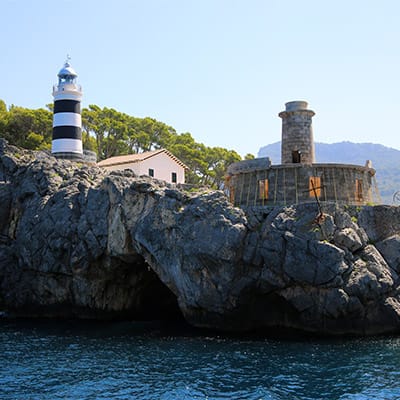
Faro de Sa Creu
El Faro Sa Creu, inaugurado en 1864, tuvo que ser reemplazado debido a las adversas condiciones topográficas y los fuertes vientos.
Por lo tanto, se llevó a cabo la construcción de un nuevo faro que actualmente está en funcionamiento desde 1944.
The Sa Creu lighthouse, inaugurated in 1864, had to be replaced due to adverse topographical conditions and strong winds.
Therefore, the construction of a new lighthouse was carried out, which has been in operation since 1944.
Der 1864 eingeweihte Leuchtturm von Sa Creu musste aufgrund der ungünstigen topografischen Bedingungen und der starken Winde ersetzt werden.
Daher wurde ein neuer Leuchtturm gebaut, der seit 1944 in Betrieb ist.
El Faro Sa Creu, inaugurado en 1864, tuvo que ser reemplazado debido a las adversas condiciones topográficas y los fuertes vientos.
Por lo tanto, se llevó a cabo la construcción de un nuevo faro que actualmente está en funcionamiento desde 1944.
The Sa Creu lighthouse, inaugurated in 1864, had to be replaced due to adverse topographical conditions and strong winds.
Therefore, the construction of a new lighthouse was carried out, which has been in operation since 1944.
Der 1864 eingeweihte Leuchtturm von Sa Creu musste aufgrund der ungünstigen topografischen Bedingungen und der starken Winde ersetzt werden.
Daher wurde ein neuer Leuchtturm gebaut, der seit 1944 in Betrieb ist.
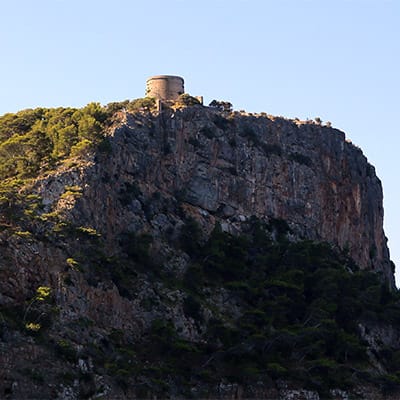
Sa Torre Picada
A lo largo de la costa de Mallorca se encuentran 37 torres de vigilancia construidas entre los siglos XVI y XVII, cuya función era detectar barcos procedentes del norte de África que atacaban los pueblos costeros de Tramontana.
En 1561, Sóller fue víctima de un ataque de piratas que saquearon la ciudad.
Afortunadamente, los valientes habitantes de Sóller lograron derrotar a los piratas.
Como medida preventiva ante posibles futuros ataques, se construyó la Torre Picada para proteger y vigilar la zona.
Along the coast of Mallorca there are 37 watchtowers built between the 16th and 17th centuries, whose function was to detect ships from North Africa attacking the coastal towns of Tramontana.
In 1561, Sóller was the victim of an attack by pirates who sacked the town.
Fortunately, the brave inhabitants of Sóller managed to defeat the pirates.
As a preventive measure against possible future attacks, the Torre Picada was built to protect and watch over the area.
Entlang der Küste Mallorcas gibt es 37 Wachtürme, die zwischen dem 16. und 17. Jahrhundert erbaut wurden und deren Aufgabe es war, Schiffe aus Nordafrika aufzuspüren, die die Küstenorte der Tramontana angriffen.
Im Jahr 1561 wurde Sóller Opfer eines Angriffs von Piraten, die die Stadt plünderten.
Glücklicherweise gelang es den tapferen Einwohnern von Sóller, die Piraten zu besiegen.
Als Präventivmaßnahme gegen mögliche künftige Angriffe wurde der Torre Picada zum Schutz und zur Bewachung der Gegend errichtet.
A lo largo de la costa de Mallorca se encuentran 37 torres de vigilancia construidas entre los siglos XVI y XVII, cuya función era detectar barcos procedentes del norte de África que atacaban los pueblos costeros de Tramontana.
En 1561, Sóller fue víctima de un ataque de piratas que saquearon la ciudad.
Afortunadamente, los valientes habitantes de Sóller lograron derrotar a los piratas.
Como medida preventiva ante posibles futuros ataques, se construyó la Torre Picada para proteger y vigilar la zona.
Along the coast of Mallorca there are 37 watchtowers built between the 16th and 17th centuries, whose function was to detect ships from North Africa attacking the coastal towns of Tramontana.
In 1561, Sóller was the victim of an attack by pirates who sacked the town.
Fortunately, the brave inhabitants of Sóller managed to defeat the pirates.
As a preventive measure against possible future attacks, the Torre Picada was built to protect and watch over the area.
Entlang der Küste Mallorcas gibt es 37 Wachtürme, die zwischen dem 16. und 17. Jahrhundert erbaut wurden und deren Aufgabe es war, Schiffe aus Nordafrika aufzuspüren, die die Küstenorte der Tramontana angriffen.
Im Jahr 1561 wurde Sóller Opfer eines Angriffs von Piraten, die die Stadt plünderten.
Glücklicherweise gelang es den tapferen Einwohnern von Sóller, die Piraten zu besiegen.
Als Präventivmaßnahme gegen mögliche künftige Angriffe wurde der Torre Picada zum Schutz und zur Bewachung der Gegend errichtet.
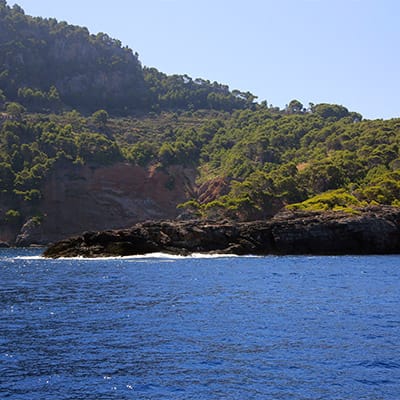
Ses Puntes
La zona denominada 'Ses Puntes' fue el punto de desembarco por el cual los piratas accedieron para saquear la ciudad de Sóller en 1561.
En este lugar de la costa, los piratas llevaron a cabo su incursión dejando una significativa marca en la historia local.
The area known as 'Ses Puntes' was the landing point through which the pirates came to sack the town of Sóller in 1561.
At this spot on the coast, the pirates carried out their raid, leaving a significant mark on local history.
Das Gebiet, das als "Ses Puntes" bekannt ist, war der Landepunkt, über den die Piraten im Jahr 1561 die Stadt Sóller überfielen.
An dieser Stelle an der Küste führten die Piraten ihren Raubzug durch und hinterließen ein bedeutendes Zeichen in der lokalen Geschichte.
La zona denominada 'Ses Puntes' fue el punto de desembarco por el cual los piratas accedieron para saquear la ciudad de Sóller en 1561.
En este lugar de la costa, los piratas llevaron a cabo su incursión dejando una significativa marca en la historia local.
The area known as 'Ses Puntes' was the landing point through which the pirates came to sack the town of Sóller in 1561.
At this spot on the coast, the pirates carried out their raid, leaving a significant mark on local history.
Das Gebiet, das als "Ses Puntes" bekannt ist, war der Landepunkt, über den die Piraten im Jahr 1561 die Stadt Sóller überfielen.
An dieser Stelle an der Küste führten die Piraten ihren Raubzug durch und hinterließen ein bedeutendes Zeichen in der lokalen Geschichte.
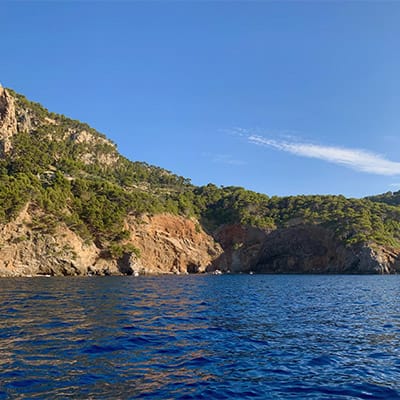
Ses Cambres
Ses Cambres es una pequeña cala del municipio de Sóller, accesible solo en barco. Desde aquí, se puede disfrutar de la belleza del entorno marino.
Sus aguas cristalinas y la tranquilidad del lugar lo convierten en un destino encantador para los amantes de la naturaleza.
Ses Cambres is a small cove in the municipality of Sóller, accessible only by boat. From here, you can enjoy the beauty of the marine environment.
Its crystal-clear waters and the tranquillity of the place make it a charming destination for nature lovers.
Ses Cambres ist eine kleine Bucht in der Gemeinde Sóller, die nur per Boot erreichbar ist. Von hier aus kann man die Schönheit der Meeresumwelt genießen.
Das kristallklare Wasser und die Ruhe des Ortes machen ihn zu einem reizvollen Ziel für Naturliebhaber.
Ses Cambres es una pequeña cala del municipio de Sóller, accesible solo en barco. Desde aquí, se puede disfrutar de la belleza del entorno marino.
Sus aguas cristalinas y la tranquilidad del lugar lo convierten en un destino encantador para los amantes de la naturaleza.
Ses Cambres is a small cove in the municipality of Sóller, accessible only by boat. From here, you can enjoy the beauty of the marine environment.
Its crystal-clear waters and the tranquillity of the place make it a charming destination for nature lovers.
Ses Cambres ist eine kleine Bucht in der Gemeinde Sóller, die nur per Boot erreichbar ist. Von hier aus kann man die Schönheit der Meeresumwelt genießen.
Das kristallklare Wasser und die Ruhe des Ortes machen ihn zu einem reizvollen Ziel für Naturliebhaber.
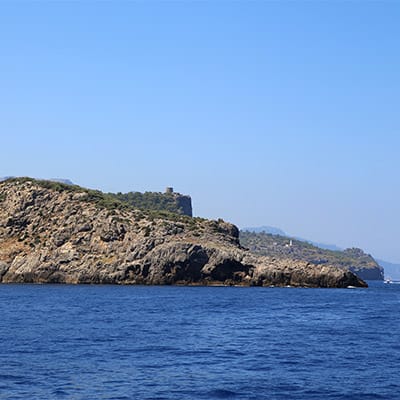
S'illeta
Illeta, cuyo nombre significa "isla pequeña", fue utilizada en el pasado como lazareto.
Este lugar histórico ofrece a veces la oportunidad de avistar cabras salvajes de la raza autóctona mallorquina, añadiendo un toque de vida silvestre al entorno.
Illeta, whose name means "little island", was once used as a lazaretto.
This historic site sometimes offers the opportunity to spot wild goats of the native Mallorcan breed, adding a touch of wildlife to the surroundings.
Illeta, dessen Name "kleine Insel" bedeutet, wurde früher als Lazarett genutzt.
An diesem historischen Ort kann man manchmal wilde Ziegen der einheimischen mallorquinischen Rasse beobachten, die der Umgebung einen Hauch von Wildnis verleihen.
Illeta, cuyo nombre significa "isla pequeña", fue utilizada en el pasado como lazareto.
Este lugar histórico ofrece a veces la oportunidad de avistar cabras salvajes de la raza autóctona mallorquina, añadiendo un toque de vida silvestre al entorno.
Illeta, whose name means "little island", was once used as a lazaretto.
This historic site sometimes offers the opportunity to spot wild goats of the native Mallorcan breed, adding a touch of wildlife to the surroundings.
Illeta, dessen Name "kleine Insel" bedeutet, wurde früher als Lazarett genutzt.
An diesem historischen Ort kann man manchmal wilde Ziegen der einheimischen mallorquinischen Rasse beobachten, die der Umgebung einen Hauch von Wildnis verleihen.
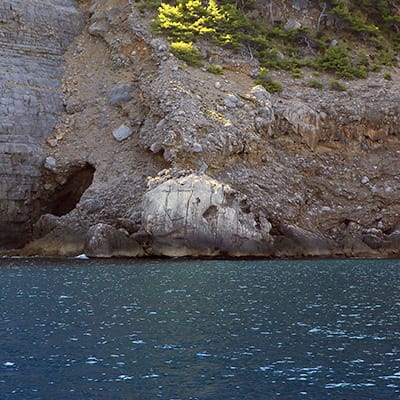
La Calavera
Sa Calavera es una formación rocosa única que se asemeja a un cráneo humano.
Esta sorprendente roca, resultado de la erosión, es una curiosidad en la costa que captura la atención de los visitantes.
Sa Calavera is a unique rock formation that resembles a human skull.
This surprising rock, the result of erosion, is a curiosity on the coast that captures the attention of visitors.
Sa Calavera ist eine einzigartige Felsformation, die einem menschlichen Schädel ähnelt.
Dieser überraschende Felsen, der durch Erosion entstanden ist, ist eine Kuriosität an der Küste, die die Aufmerksamkeit der Besucher auf sich zieht.
Sa Calavera es una formación rocosa única que se asemeja a un cráneo humano.
Esta sorprendente roca, resultado de la erosión, es una curiosidad en la costa que captura la atención de los visitantes.
Sa Calavera is a unique rock formation that resembles a human skull.
This surprising rock, the result of erosion, is a curiosity on the coast that captures the attention of visitors.
Sa Calavera ist eine einzigartige Felsformation, die einem menschlichen Schädel ähnelt.
Dieser überraschende Felsen, der durch Erosion entstanden ist, ist eine Kuriosität an der Küste, die die Aufmerksamkeit der Besucher auf sich zieht.
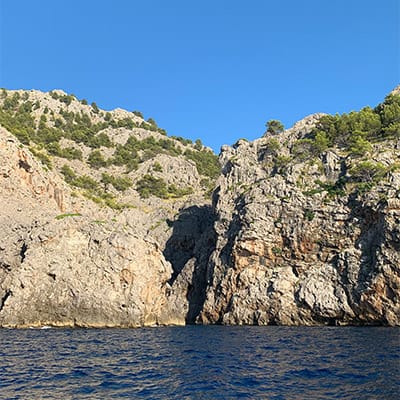
Torrente de na Mora
El Torrent de Na Mora, en el termino municipal de Fornalutx, es un torrente de montaña en la Sierra de Tramontana, con una longitud de 1500 metros.
Su desembocadura es impresionante cuando lleva un gran caudal de agua.
Este torrente es muy popular entre los amantes del barranquismo.
The Torrent de Na Mora, in the municipality of Fornalutx, is a mountain torrent in the Sierra de Tramontana, with a length of 1500 metres.
Its mouth is impressive when it carries a large volume of water.
This torrent is very popular with canyoning enthusiasts.
Der Torrent de Na Mora im Gemeindegebiet von Fornalutx ist ein Gebirgsbach in der Sierra de Tramontana mit einer Länge von 1500 Metern.
Seine Mündung ist beeindruckend, wenn er eine große Menge Wasser führt.
Dieser Sturzbach ist bei Canyoning-Fans sehr beliebt.
El Torrent de Na Mora, en el termino municipal de Fornalutx, es un torrente de montaña en la Sierra de Tramontana, con una longitud de 1500 metros.
Su desembocadura es impresionante cuando lleva un gran caudal de agua.
Este torrente es muy popular entre los amantes del barranquismo.
The Torrent de Na Mora, in the municipality of Fornalutx, is a mountain torrent in the Sierra de Tramontana, with a length of 1500 metres.
Its mouth is impressive when it carries a large volume of water.
This torrent is very popular with canyoning enthusiasts.
Der Torrent de Na Mora im Gemeindegebiet von Fornalutx ist ein Gebirgsbach in der Sierra de Tramontana mit einer Länge von 1500 Metern.
Seine Mündung ist beeindruckend, wenn er eine große Menge Wasser führt.
Dieser Sturzbach ist bei Canyoning-Fans sehr beliebt.

Cabeza de Caballo
Cap de Cavall es una curiosa formación rocosa que sobresale del acantilado y se asemeja a la cabeza de un caballo.
Esta singular roca captura la atención de los visitantes con su forma distintiva, añadiendo un toque de asombro y belleza al paisaje costero.
Cap de Cavall is a curious rock formation that juts out from the cliff and resembles the head of a horse.
This unique rock captures the attention of visitors with its distinctive shape, adding a touch of wonder and beauty to the coastal landscape.
Das Cap de Cavall ist eine kuriose Felsformation, die aus der Steilküste herausragt und an einen Pferdekopf erinnert.
Dieser einzigartige Felsen zieht die Aufmerksamkeit der Besucher mit seiner unverwechselbaren Form auf sich und verleiht der Küstenlandschaft einen Hauch von Wunder und Schönheit.
Cap de Cavall es una curiosa formación rocosa que sobresale del acantilado y se asemeja a la cabeza de un caballo.
Esta singular roca captura la atención de los visitantes con su forma distintiva, añadiendo un toque de asombro y belleza al paisaje costero.
Cap de Cavall is a curious rock formation that juts out from the cliff and resembles the head of a horse.
This unique rock captures the attention of visitors with its distinctive shape, adding a touch of wonder and beauty to the coastal landscape.
Das Cap de Cavall ist eine kuriose Felsformation, die aus der Steilküste herausragt und an einen Pferdekopf erinnert.
Dieser einzigartige Felsen zieht die Aufmerksamkeit der Besucher mit seiner unverwechselbaren Form auf sich und verleiht der Küstenlandschaft einen Hauch von Wunder und Schönheit.
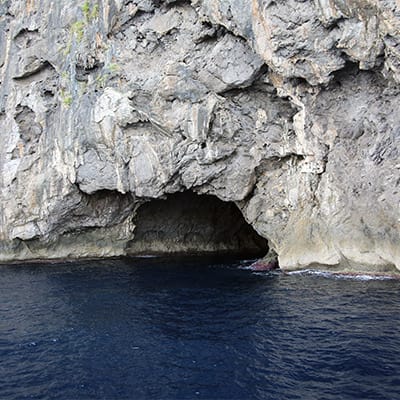
Cueva de las tres Marias
A lo largo de la costa norte encontrarás varias cuevas, incluida la impresionante Cova de ses Tres Maries.
Estas cuevas solían ser utilizadas por contrabandistas para ocultar sus mercancías, agregando un toque de intriga y aventura al paisaje costero.
Along the north coast you will find several caves, including the impressive Cova de ses Tres Maries.
These caves used to be used by smugglers to hide their goods, adding a touch of intrigue and adventure to the coastal landscape.
Entlang der Nordküste finden Sie mehrere Höhlen, darunter die beeindruckende Cova de ses Tres Maries.
Diese Höhlen wurden früher von Schmugglern als Versteck für ihre Waren genutzt und verleihen der Küstenlandschaft einen Hauch von Intrige und Abenteuer.
A lo largo de la costa norte encontrarás varias cuevas, incluida la impresionante Cova de ses Tres Maries.
Estas cuevas solían ser utilizadas por contrabandistas para ocultar sus mercancías, agregando un toque de intriga y aventura al paisaje costero.
Along the north coast you will find several caves, including the impressive Cova de ses Tres Maries.
These caves used to be used by smugglers to hide their goods, adding a touch of intrigue and adventure to the coastal landscape.
Entlang der Nordküste finden Sie mehrere Höhlen, darunter die beeindruckende Cova de ses Tres Maries.
Diese Höhlen wurden früher von Schmugglern als Versteck für ihre Waren genutzt und verleihen der Küstenlandschaft einen Hauch von Intrige und Abenteuer.
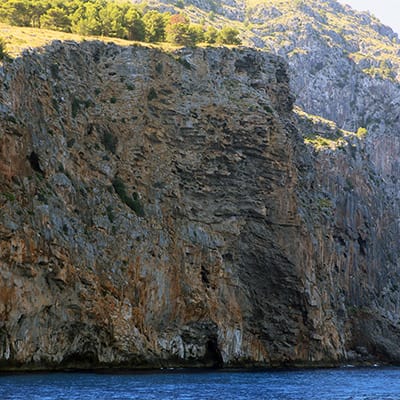
Nido de Aguila
La costa norte es un refugio para diversas aves marinas, incluyendo migratorias como el halcón de Leonor y el águila pescadora.
En este acantilado en particular, puedes encontrar dos nidos de águila pescadora escondidos entre los agujeros.
¿Te atreves a encontrarlos?
Explora este lugar fascinante y disfruta de la emoción de descubrir la vida silvestre en su hábitat natural.
The north coast is a haven for a variety of seabirds, including migratory birds such as the Eleonora's falcon and the osprey.
On this particular cliff, you can find two osprey nests hidden among the holes.
Do you dare to find them?
Explore this fascinating place and enjoy the thrill of discovering wildlife in its natural habitat.
Die Nordküste ist ein Paradies für eine Vielzahl von Seevögeln, darunter Zugvögel wie der Eleonorenfalke und der Fischadler.
Auf dieser besonderen Klippe finden Sie zwei Fischadler-Nester, die in den Löchern versteckt sind.
Trauen Sie sich, sie zu finden?
Erkunden Sie diesen faszinierenden Ort und genießen Sie den Nervenkitzel, wilde Tiere in ihrem natürlichen Lebensraum zu entdecken.
La costa norte es un refugio para diversas aves marinas, incluyendo migratorias como el halcón de Leonor y el águila pescadora.
En este acantilado en particular, puedes encontrar dos nidos de águila pescadora escondidos entre los agujeros.
¿Te atreves a encontrarlos?
Explora este lugar fascinante y disfruta de la emoción de descubrir la vida silvestre en su hábitat natural.
The north coast is a haven for a variety of seabirds, including migratory birds such as the Eleonora's falcon and the osprey.
On this particular cliff, you can find two osprey nests hidden among the holes.
Do you dare to find them?
Explore this fascinating place and enjoy the thrill of discovering wildlife in its natural habitat.
Die Nordküste ist ein Paradies für eine Vielzahl von Seevögeln, darunter Zugvögel wie der Eleonorenfalke und der Fischadler.
Auf dieser besonderen Klippe finden Sie zwei Fischadler-Nester, die in den Löchern versteckt sind.
Trauen Sie sich, sie zu finden?
Erkunden Sie diesen faszinierenden Ort und genießen Sie den Nervenkitzel, wilde Tiere in ihrem natürlichen Lebensraum zu entdecken.
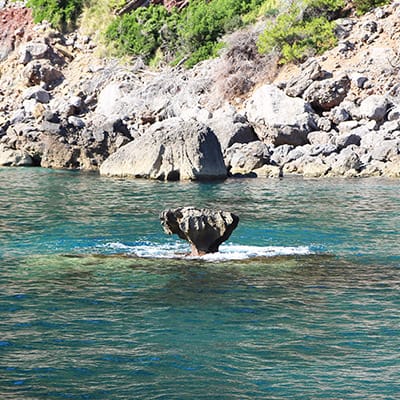
El Champiñon
Es Xampinyó es una formación rocosa que ha sido moldeada por la erosión marina a lo largo de los años.
Esta maravilla natural adopta la peculiar forma de un champiñón.
Su creación es el resultado de la poderosa acción del agua y el transcurso del tiempo.
Es Xampinyó is a rock formation that has been shaped by marine erosion over the years.
This natural wonder adopts the peculiar shape of a mushroom.
Its creation is the result of the powerful action of water and the passage of time.
Es Xampinyó ist eine Felsformation, die im Laufe der Jahre durch Meereserosion entstanden ist.
Dieses Naturwunder hat die eigentümliche Form eines Pilzes.
Seine Entstehung ist das Ergebnis der starken Wirkung des Wassers und des Laufs der Zeit.
Es Xampinyó es una formación rocosa que ha sido moldeada por la erosión marina a lo largo de los años.
Esta maravilla natural adopta la peculiar forma de un champiñón.
Su creación es el resultado de la poderosa acción del agua y el transcurso del tiempo.
Es Xampinyó is a rock formation that has been shaped by marine erosion over the years.
This natural wonder adopts the peculiar shape of a mushroom.
Its creation is the result of the powerful action of water and the passage of time.
Es Xampinyó ist eine Felsformation, die im Laufe der Jahre durch Meereserosion entstanden ist.
Dieses Naturwunder hat die eigentümliche Form eines Pilzes.
Seine Entstehung ist das Ergebnis der starken Wirkung des Wassers und des Laufs der Zeit.
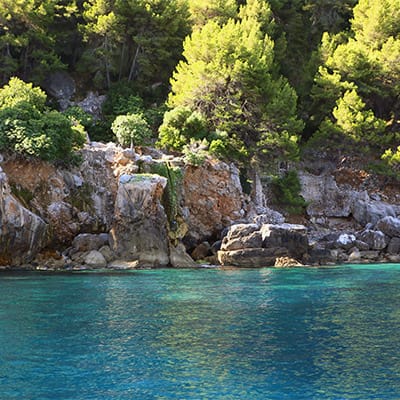
Fuente de Sa Costera
La Font de sa Costera es una fuente de agua natural que nace en la Sierra de Tramontana.
A principios del siglo 20 se utilizó para generar electricidad para el pueblo de Sóller.
Actualmente, su agua se canaliza a través de tuberías subterráneas para abastecer de agua a gran parte de la isla.
The Font de sa Costera is a natural spring that rises in the Tramontana mountain range.
At the beginning of the 20th century it was used to generate electricity for the town of Sóller.
Nowadays, its water is channelled through underground pipes to supply water to a large part of the island.
Die Font de sa Costera ist eine natürliche Quelle, die in der Tramontana-Bergkette entspringt.
Zu Beginn des 20. Jahrhunderts wurde sie zur Stromerzeugung für die Stadt Sóller genutzt.
Heute wird ihr Wasser durch unterirdische Leitungen geleitet, um einen großen Teil der Insel mit Wasser zu versorgen.
La Font de sa Costera es una fuente de agua natural que nace en la Sierra de Tramontana.
A principios del siglo 20 se utilizó para generar electricidad para el pueblo de Sóller.
Actualmente, su agua se canaliza a través de tuberías subterráneas para abastecer de agua a gran parte de la isla.
The Font de sa Costera is a natural spring that rises in the Tramontana mountain range.
At the beginning of the 20th century it was used to generate electricity for the town of Sóller.
Nowadays, its water is channelled through underground pipes to supply water to a large part of the island.
Die Font de sa Costera ist eine natürliche Quelle, die in der Tramontana-Bergkette entspringt.
Zu Beginn des 20. Jahrhunderts wurde sie zur Stromerzeugung für die Stadt Sóller genutzt.
Heute wird ihr Wasser durch unterirdische Leitungen geleitet, um einen großen Teil der Insel mit Wasser zu versorgen.

Torre des Morro des Forat
La Torre des Forat es una de las torres de vigilancia construidas en Mallorca para protegerse de los ataques piratas.
Construida en 1611, esta torre histórica ahora se encuentra en estado de ruinas.
The Torre des Forat is one of the 37 watchtowers built in Mallorca to protect against pirate attacks.
Built in 1611, this historic tower is now in a state of ruins.
Der Torre des Forat ist einer der 37 Wachtürme, die auf Mallorca zum Schutz vor Piratenüberfällen errichtet wurden.
Dieser historische Turm wurde 1611 erbaut und ist heute eine Ruine.
La Torre des Forat es una de las torres de vigilancia construidas en Mallorca para protegerse de los ataques piratas.
Construida en 1611, esta torre histórica ahora se encuentra en estado de ruinas.
The Torre des Forat is one of the 37 watchtowers built in Mallorca to protect against pirate attacks.
Built in 1611, this historic tower is now in a state of ruins.
Der Torre des Forat ist einer der 37 Wachtürme, die auf Mallorca zum Schutz vor Piratenüberfällen errichtet wurden.
Dieser historische Turm wurde 1611 erbaut und ist heute eine Ruine.

Cala Tuent
Cala Tuent es una de las calas más singulares de Mallorca. Se distingue por los olivos centenarios que adornan sus alrededores.
Desde esta cala, se puede disfrutar de una vista privilegiada de la montaña más alta de la isla, el Puig Major.
Cala Tuent is one of the most unique coves in Mallorca. It is distinguished by the centenary olive trees that adorn its surroundings.
From this cove, you can enjoy a privileged view of the highest mountain on the island, Puig Major.
Cala Tuent ist eine der einzigartigsten Buchten Mallorcas. Sie zeichnet sich durch die hundertjährigen Olivenbäume aus, die ihre Umgebung schmücken.
Von dieser Bucht aus können Sie einen privilegierten Blick auf den höchsten Berg der Insel, den Puig Major, genießen.
Cala Tuent es una de las calas más singulares de Mallorca. Se distingue por los olivos centenarios que adornan sus alrededores.
Desde esta cala, se puede disfrutar de una vista privilegiada de la montaña más alta de la isla, el Puig Major.
Cala Tuent is one of the most unique coves in Mallorca. It is distinguished by the centenary olive trees that adorn its surroundings.
From this cove, you can enjoy a privileged view of the highest mountain on the island, Puig Major.
Cala Tuent ist eine der einzigartigsten Buchten Mallorcas. Sie zeichnet sich durch die hundertjährigen Olivenbäume aus, die ihre Umgebung schmücken.
Von dieser Bucht aus können Sie einen privilegierten Blick auf den höchsten Berg der Insel, den Puig Major, genießen.
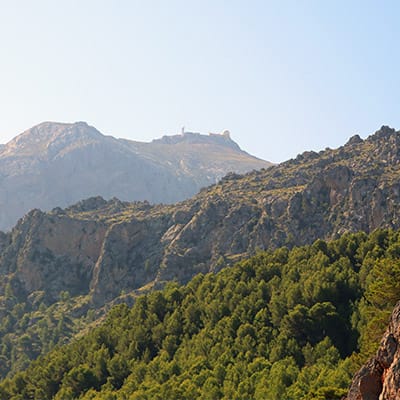
Puig Major
El Puig Major es la montaña más alta de la isla, con una altitud de 1445 metros.
En su cima se encuentra una base militar que alberga un radar capaz de cubrir gran parte del Mediterráneo.
Esta imponente montaña ofrece vistas panorámicas impresionantes de la región.
Puig Major is the highest mountain on the island, with an altitude of 1445 metres.
At its summit is a military base that houses a radar capable of covering a large part of the Mediterranean.
This imposing mountain offers breathtaking panoramic views of the region.
Der Puig Major ist der höchste Berg der Insel mit einer Höhe von 1445 Metern.
Auf seinem Gipfel befindet sich eine Militärbasis, die ein Radar beherbergt, das einen großen Teil des Mittelmeers abdecken kann.
Dieser imposante Berg bietet einen atemberaubenden Panoramablick über die Region.
El Puig Major es la montaña más alta de la isla, con una altitud de 1445 metros.
En su cima se encuentra una base militar que alberga un radar capaz de cubrir gran parte del Mediterráneo.
Esta imponente montaña ofrece vistas panorámicas impresionantes de la región.
Puig Major is the highest mountain on the island, with an altitude of 1445 metres.
At its summit is a military base that houses a radar capable of covering a large part of the Mediterranean.
This imposing mountain offers breathtaking panoramic views of the region.
Der Puig Major ist der höchste Berg der Insel mit einer Höhe von 1445 Metern.
Auf seinem Gipfel befindet sich eine Militärbasis, die ein Radar beherbergt, das einen großen Teil des Mittelmeers abdecken kann.
Dieser imposante Berg bietet einen atemberaubenden Panoramablick über die Region.
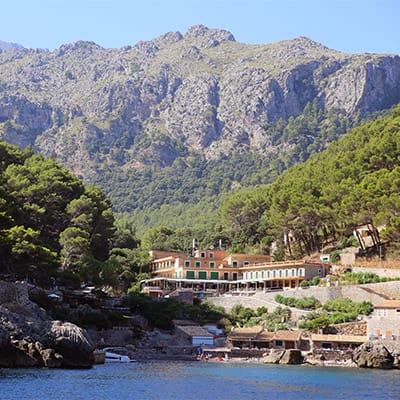
Sa Calobra
Sa Calobra, una encantadora cala situada en el municipio de Escorca, en pleno corazón de la Serra de Tramuntana y declarada Patrimonio Mundial por la UNESCO en 2011, pequeña aldea con su playa de piedras y su pintoresco muelle desde donde los Barcos Azules transportan a los pasajeros hacia el Puerto de Sóller.
En nombre de Barcos Azules, queremos expresar nuestro más sincero agradecimiento por haber elegido nuestro servicio para este maravilloso paseo en barco.
es un verdadero placer tenerlos a bordo y esperamos poder recibirlos nuevamente en el futuro.
¡Muchas gracias por su visita!
We have reached our destination.
Sa Calobra, a charming cove located in the municipality of Escorca, in the heart of the Serra de Tramuntana and declared a World Heritage Site by UNESCO in 2011, a small village with its pebble beach and its picturesque pier from where the Barcos Azules transport passengers to the Port of Sóller.
On behalf of Barcos Azules, we would like to express our sincere thanks for choosing our service for this wonderful boat trip.
It has been a real pleasure to have you on board and we look forward to welcoming you again in the future.
Thank you very much for your visit and see you soon!
Wir haben unser Ziel erreicht.
Sa Calobra, eine bezaubernde Bucht in der Gemeinde Escorca, im Herzen der Serra de Tramuntana, die 2011 von der UNESCO zum Weltkulturerbe erklärt wurde, ein kleines Dorf mit einem Kieselstrand und einer malerischen Anlegestelle, von der aus die Barcos Azules die Passagiere zum Hafen von Sóller bringen.
Im Namen der Barcos Azules möchten wir uns ganz herzlich dafür bedanken, dass Sie unseren Service für diese wunderbare Bootsfahrt gewählt haben.
Es war uns eine große Freude, Sie an Bord zu haben, und wir freuen uns darauf, Sie in Zukunft wieder begrüßen zu dürfen.
Vielen Dank für Ihren Besuch und bis bald!
Sa Calobra, una encantadora cala situada en el municipio de Escorca, en pleno corazón de la Serra de Tramuntana y declarada Patrimonio Mundial por la UNESCO en 2011, pequeña aldea con su playa de piedras y su pintoresco muelle desde donde los Barcos Azules transportan a los pasajeros hacia el Puerto de Sóller.
En nombre de Barcos Azules, queremos expresar nuestro más sincero agradecimiento por haber elegido nuestro servicio para este maravilloso paseo en barco.
es un verdadero placer tenerlos a bordo y esperamos poder recibirlos nuevamente en el futuro.
¡Muchas gracias por su visita!
We have reached our destination.
Sa Calobra, a charming cove located in the municipality of Escorca, in the heart of the Serra de Tramuntana and declared a World Heritage Site by UNESCO in 2011, a small village with its pebble beach and its picturesque pier from where the Barcos Azules transport passengers to the Port of Sóller.
On behalf of Barcos Azules, we would like to express our sincere thanks for choosing our service for this wonderful boat trip.
It has been a real pleasure to have you on board and we look forward to welcoming you again in the future.
Thank you very much for your visit and see you soon!
Wir haben unser Ziel erreicht.
Sa Calobra, eine bezaubernde Bucht in der Gemeinde Escorca, im Herzen der Serra de Tramuntana, die 2011 von der UNESCO zum Weltkulturerbe erklärt wurde, ein kleines Dorf mit einem Kieselstrand und einer malerischen Anlegestelle, von der aus die Barcos Azules die Passagiere zum Hafen von Sóller bringen.
Im Namen der Barcos Azules möchten wir uns ganz herzlich dafür bedanken, dass Sie unseren Service für diese wunderbare Bootsfahrt gewählt haben.
Es war uns eine große Freude, Sie an Bord zu haben, und wir freuen uns darauf, Sie in Zukunft wieder begrüßen zu dürfen.
Vielen Dank für Ihren Besuch und bis bald!

Torrent de Pareis
El Torrent de Paréis es un impresionante cañón con paredes verticales de más de 200 metros de altura. Se origina en el Gorg Blau y se extiende a lo largo de 3 km.
En verano, es una popular ruta senderista que requiere experiencia y conocimiento de la zona por lo que desde barcos azules recomendamos realizarla con guías experimentados. Además, cada año se celebra un concierto al aire libre en este impresionante entorno.
The Torrent de Paréis is an impressive canyon with vertical walls over 200 metres high. It originates in the Gorg Blau and stretches for 3 km.
In summer, it is a popular hiking route that requires experience and knowledge of the area, which is why we at barcos azules recommend that you do it with experienced guides. In addition, every year an open-air concert is held in this stunning setting.
Der Torrent de Paréis ist eine beeindruckende Schlucht mit senkrechten, über 200 m hohen Wänden. Er entspringt in der Gorg Blau und erstreckt sich über 3 km.
Im Sommer ist er eine beliebte Wanderroute, die Erfahrung und Ortskenntnis erfordert, weshalb wir von barcos azules empfehlen, sie mit erfahrenen Führern zu begehen. Außerdem findet jedes Jahr ein Open-Air-Konzert in dieser atemberaubenden Kulisse statt.
El Torrent de Paréis es un impresionante cañón con paredes verticales de más de 200 metros de altura. Se origina en el Gorg Blau y se extiende a lo largo de 3 km.
En verano, es una popular ruta senderista que requiere experiencia y conocimiento de la zona por lo que desde barcos azules recomendamos realizarla con guías experimentados. Además, cada año se celebra un concierto al aire libre en este impresionante entorno.
The Torrent de Paréis is an impressive canyon with vertical walls over 200 metres high. It originates in the Gorg Blau and stretches for 3 km.
In summer, it is a popular hiking route that requires experience and knowledge of the area, which is why we at barcos azules recommend that you do it with experienced guides. In addition, every year an open-air concert is held in this stunning setting.
Der Torrent de Paréis ist eine beeindruckende Schlucht mit senkrechten, über 200 m hohen Wänden. Er entspringt in der Gorg Blau und erstreckt sich über 3 km.
Im Sommer ist er eine beliebte Wanderroute, die Erfahrung und Ortskenntnis erfordert, weshalb wir von barcos azules empfehlen, sie mit erfahrenen Führern zu begehen. Außerdem findet jedes Jahr ein Open-Air-Konzert in dieser atemberaubenden Kulisse statt.

Morro de Sa Vaca
El Morro de sa Vaca es un acantilado que se eleva aproximadamente 300 metros verticalmente hacia el mar.
Recibe su nombre debido a su similitud con la forma del morro de una vaca.
Morro de sa Vaca is a cliff that rises approximately 300 metres vertically towards the sea.
It gets its name from its similarity to the shape of a cow's snout.
Der Morro de sa Vaca ist eine Klippe, die etwa 300 Meter senkrecht zum Meer hin ansteigt.
Seinen Namen verdankt er der Ähnlichkeit mit der Form einer Kuhschnauze.
El Morro de sa Vaca es un acantilado que se eleva aproximadamente 300 metros verticalmente hacia el mar.
Recibe su nombre debido a su similitud con la forma del morro de una vaca.
Morro de sa Vaca is a cliff that rises approximately 300 metres vertically towards the sea.
It gets its name from its similarity to the shape of a cow's snout.
Der Morro de sa Vaca ist eine Klippe, die etwa 300 Meter senkrecht zum Meer hin ansteigt.
Seinen Namen verdankt er der Ähnlichkeit mit der Form einer Kuhschnauze.
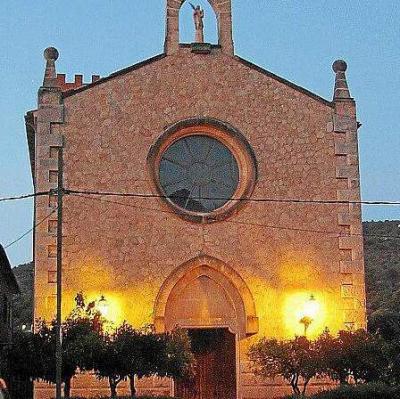
Iglesia Mare de Deu de la Victoria
Estás llegando a la iglesia de la Mare de Déu de la Victoria, El edificio que hoy pueden ver fue construido entre 1714 y 1790. Se trata de una iglesia de planta basilical, con capillas laterales y abovedadas.
En el altar mayor pueden observar su pieza más destacada, un retablo barroco dedicado a la Mare de Déu realizado entre 1752 y 1764 por el escultor mallorquín Pere Joan Obrador.
You are arriving at the church of the Mare de Déu de la Victoria. The building that you can see today was built between 1714 and 1790. It is a church with a basilica plan, with side and vaulted chapels.
In the main altar you can see its most outstanding piece, a baroque altarpiece dedicated to the Mare de Déu made between 1752 and 1764 by the Mallorcan sculptor Pere Joan Obrador.
Sie erreichen die Kirche Mare de Déu de la Victoria, das Gebäude, das Sie heute sehen können, wurde zwischen 1714 und 1790 erbaut, eine Kirche mit basilikalem Grundriss, mit Seiten- und Gewölbekapellen.
Im Hauptaltar können Sie das herausragendste Stück sehen, ein barockes Altarbild, das der Mare de Déu gewidmet ist und zwischen 1752 und 1764 vom mallorquinischen Bildhauer Pere Joan Obrador angefertigt wurde.

Iglesia de San Bartolomé
En la Plaza de la Constitución de Sóller se alza imponente un edificio de roca caliza de color grisáceo en el que todavía hoy se pueden apreciar las diferentes remodelaciones que ha sufrido a lo largo de los años. Se trata de la iglesia parroquial de Sant Bartomeu de Sóller.
Construido antes del 1236, el templo primitivo era de estilo románico-gótico y distaba mucho de la actual: era más pequeño y tenía la entrada principal situada en el que ahora se conoce como Portal de Dalt (entrada lateral del templo). En 1688 se derrumba parcialmente la iglesia original y se empieza a construir una nueva iglesia de estilo barroco que no se terminó de construir hasta 1733. Durante esta reforma se construye la estructura barroca del templo y se cambia el orientación.
La tercera y última reforma se llevó a cabo entre los años 1904 y 1947. Después de una larga pausa que duró de 1913 hasta 1946, se dio por terminada la actual fachada proyectada por el discípulo de Gaudí, Joan Rubió Bellver.
Gracias a su atrio coronado por un gran arco apuntado con dos arcos ojivales y un rosetón y, sobre éste, un remate escalonado con nueve aperturas, la iglesia parroquial de Sant Bartomeu de Sóller ha convertido en una de las postales de nuestro valle y un muestra de como el modernista Art Nouveau se mezclaba con historicismo gótico.
In the Plaza de la Constitución in Sóller stands an imposing building made of greyish limestone rock in which the different remodelling work it has undergone over the years can still be seen today. This is the parish church of Sant Bartomeu de Sóller.
An der Plaza de la Constitución in Sóller steht ein imposantes Gebäude aus grauem Kalkstein, an dem man noch heute die verschiedenen Umgestaltungen erkennen kann, die es im Laufe der Jahre erfahren hat. Es handelt sich um die Pfarrkirche von Sant Bartomeu de Sóller.
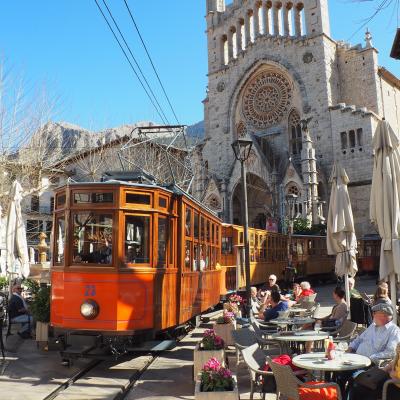
Plaza de Soller
La Plaza de la Constitución es considerada una de las más bellas de Mallorca debido a su ágora central de piedra rosada con un surtidor de agua y el conjunto de edificios modernistas que la rodean, como la Iglesia de Sant Bartomeu, el Banco de Sóller, Can Bordils y la Casa Consistorial. Actualmente, es el centro social y festivo del pueblo, donde se celebran la mayoría de fiestas y actos populares.
La Casa Consistorial o Ayuntamiento se encuentra a la derecha de la iglesia de Sóller. Es un edificio barroco proyectado por el arquitecto Antoni Coll e inaugurado en 1733. En la parte superior de su fachada se encuentra un gran escudo de Sóller, que fue inaugurado en 1976.
The Plaza de la Constitución is considered one of the most beautiful squares in Mallorca due to its central agora of pink stone with a water fountain and the group of modernist buildings that surround it, such as the Church of Sant Bartomeu, the Banco de Sóller, Can Bordils and the Casa Consistorial (Town Hall). Nowadays, it is the social and festive centre of the town, where most of the festivals and popular events are held.
The Casa Consistorial or Town Hall is located to the right of the church of Sóller. It is a Baroque building designed by the architect Antoni Coll and inaugurated in 1733. On the upper part of its façade is a large coat of arms of Sóller, which was inaugurated in 1976.
Die Plaza de la Constitución gilt als einer der schönsten Plätze Mallorcas, da sie von einer zentralen Agora aus rosafarbenem Stein mit einem Wasserbrunnen und einer Reihe modernistischer Gebäude umgeben ist, darunter die Kirche Sant Bartomeu, die Banco de Sóller, Can Bordils und die Casa Consistorial (Rathaus). Heute ist er das gesellschaftliche und festliche Zentrum der Stadt, in dem die meisten Feste und Volksveranstaltungen stattfinden.
Das Casa Consistorial oder Rathaus befindet sich rechts von der Kirche von Sóller. Es handelt sich um ein barockes Gebäude, das von dem Architekten Antoni Coll entworfen und 1733 eingeweiht wurde. Am oberen Teil der Fassade befindet sich ein großes Wappen von Sóller, das 1976 eingeweiht wurde.
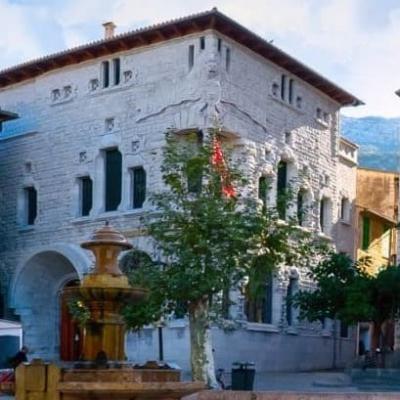
Banco de Soller
El Banco de Sóller, diseñado por Joan Rubió i Bellver, discípulo de Antonio Gaudí, fue construido en 1904 con el objetivo de ofrecer servicios bancarios a los emigrantes que habían vuelto a su pueblo después de hacer fortuna en el extranjero y a los habitantes locales.
El banco encaja a la perfección con la iglesia de Sant Bartolomé, obra del mismo arquitecto, y da un aire modernista-gaudiniano a toda la Plaza de la Constitución.
The Banco de Sóller, designed by Joan Rubió i Bellver, a disciple of Antonio Gaudí, was built in 1904 with the aim of offering banking services to emigrants who had returned to their village after making their fortune abroad and to the local inhabitants.
Die von Joan Rubió i Bellver, einem Schüler Antonio Gaudís, entworfene Banco de Sóller wurde 1904 mit dem Ziel erbaut, den Auswanderern, die nach ihrem Glück im Ausland in ihr Dorf zurückgekehrt waren, und den Einheimischen Bankdienstleistungen anzubieten.
-

Bienvenida a Excursiones Marítimas
-

Parking
-

Faro de Sa Creu
-

Sa Torre Picada
-

Ses Puntes
-

Ses Cambres
-

S'illeta
-

La Calavera
-

Torrente de na Mora
-

Cabeza de Caballo
-

Cueva de las tres Marias
-

Nido de Aguila
-

El Champiñon
-

Fuente de Sa Costera
-

Torre des Morro des Forat
-

Cala Tuent
-

Puig Major
-

Sa Calobra
-

Torrent de Pareis
-

Morro de Sa Vaca
-

Iglesia Mare de Deu de la Victoria
-

Iglesia de San Bartolomé
-

Plaza de Soller
-

Banco de Soller
This web application requires you to accept location permissions, and for the iPhone you must disable the automatic screen shutdown (Settings=>Screen and brightness=>Auto lock).
YOU SHOULD NOT CLOSE THE BROWSER as you will lose the preloaded data, although the phone can be closed.

Open the app on another phone with this QR image
YOU SHOULD NOT CLOSE THE BROWSER as you will lose the preloaded data, although the phone can be closed.

Open the app on another phone with this QR image